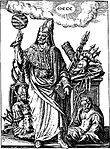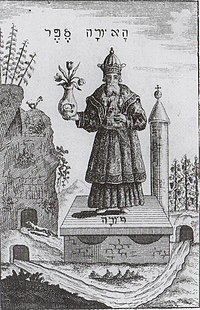Hermetism and other religions
| Part of a series on |
| Hermeticism |
|---|
 |
This is a comparative religion article which outlines the similarities and interactions between Hermeticism (or Hermetism) and other religions or philosophies. It highlights its similarities and differences with Gnosticism, examines its connections in Islam and Judaism, delves into its influence on Christianity, and even explores its potential impact on Mormonism. In essence, it unveils how Hermeticism has engaged with, influenced, and been influenced by a diverse array of spiritual and philosophical traditions throughout history.
Ancient philosophy
Hermetism had a strong philosophical influence,[1] especially from Stoicism and Platonism.[2]
Gnosticism
Hermetism is related to a wider intellectual current known as Gnosticism.[3] Both flourished in the same period in Roman Egypt, in the same spiritual climate,[4] sharing the goal of allowing the soul to escape from the material realm, and emphasizing a personal knowledge of God. Both groups held that the fundamental relationship between God and man could be found through gnosis (knowledge, understanding), with the goal to "see" God, and in some instances to become one with God.[1]
However, there are also some significant differences between Hermetism and Gnosticism with regard to philosophical
Islam
According to ninth- and tenth-century Arabic authors, the pagan community from the Upper-Mesopotamian city of
Judaism
The relationship between Judaism and Hermetism has been one of mutual influence and a subject of controversy within the Jewish religion.[14]
Middle Ages
This identification paved the way for the exchange and melding of ideas between Judaism and Hermetism during the
Hermetism and Kabbalah arose together in the 12th and 13th centuries. The Practical Kabbalah also relied upon magic and astrology but focused more on the Hebrew language in its incantations than the general language of Hermetism in general.[17]
Secondly, Jewish scholars of the Middle Ages attempted to make use of treatises on
These Jewish scholars, particularly the ones who distrusted
In the use of these Hermetic treatises, these Jewish scholars, though at times inadvertently, introduced Hermetic ideas into Jewish thought.
However, most Medieval Jewish scholars aware of the Hermetic tradition did not mention Hermetism explicitly, but rather referred to them through Hermetic ideas that were borrowed from Islam or brought Hermeticism up only to reject it. While scholars such as
Scholars, such as Abraham ibn Ezra, felt justified in invoking the authority of Hermes to offer esoteric explanations of Jewish ritual. This culminated in a wide use of Hermetic texts for the use of theurgy and
Renaissance

Despite Maimonides' denunciation of Hermetism, Jewish scholars in the Renaissance struggled to reconcile his beliefs with those of the proponents of Hermetic thought within Judaism. Renaissance scholars argued that the rationalism of Maimonides drew upon the prisca sapienta that had both Mosaic and Hermetic origins and that Abraham ibn Ezra's Commentary on the Pentateuch was evidence that they shared the same views on the relationship between religion and science.[14]
However, scholars such as
The works of Baruch Spinoza have also been ascribed a Hermetic element[19] and Hermetic influenced thinkers such as Johann Wolfgang von Goethe have accepted Spinoza's version of God.[20]
Christianity
Christianity and Hermetism have interacted in such a way that controversy surrounds the nature of the influence. Some, such as
According to
The Fourth Gospel
Lyman also sees important similarities between the
In Lyman's analysis, both texts utilize the concept of
Lyman also points out four distinct contrasts between the two works despite their similarities. First, that the Fourth Gospel is a homogeneous work while the Corpus Hermeticum is a work which is found in fragments which she suspects were written by many authors over a wide range of time.
Mormonism
A theory by John L. Brooke, an author and professor at Tufts University, suggests that Mormonism has its roots in Hermetism and Hermeticism after following a philosophical trail from Renaissance Europe. The early Mormons, most notably Joseph Smith, were linked by Brooke with magic, alchemy, Freemasonry, divining and "other elements of radical religion" prior to Mormonism. Brooke attested correlations with the view that spirit and matter are one and the same, the covenant of celestial marriage, and the ability of humanity to become deified or ultimately perfect.[33]
Further, Brooke argued that Mormonism can only be understood in conjunction with the occult and the
However, Philip I. Barlow has criticized Brooke's work as carelessly seeking out relations to Hermeticism which Brooke knows better than Mormonism, and believes that Brooke's links to Hermeticism can be explained away with "a particular and selectively literal reading of the Bible."[33]
References
- ^ a b Van den Broek 1998, p. 1.
- ^ Van den Broek 1998, p. 5.
- ^ Quispel 1992.
- ^ Van den Broek 1998, p. 17.
- ^ Van den Broek 1998, p. 6.
- ^ Van den Broek 1998, p. 7.
- ^ Van den Broek 1998, p. 8.
- ^ Van den Broek 1998, pp. 12–13.
- ^ Van den Broek 1998, pp. 9–10.
- ^ Van den Broek 1998, pp. 11–12.
- ^ Van den Broek 1998, pp. 16–17.
- ^ Van Bladel 2009, pp. 64-114 (see especially the conclusion, pp. 113-114).
- ^ Van Bladel 2009, pp. 164-172 et passim.
- ^ a b c d e f g h i j Lelli 2007.
- ^ a b Leslie 1999.
- ^ Regardie 1940, p. 15.
- ^ Wieczynski 1975, p. 22.
- ^ Skalli 2007.
- ^ Weststeijn 2007.
- ^ Lange 2007.
- ^ a b Lyman 1930, p. 265.
- ^ a b Lyman 1930, p. 268.
- ^ a b c Lyman 1930, p. 269.
- ^ Lyman 1930, p. 271.
- ^ Lyman 1930, p. 266.
- ^ Lyman 1930, p. 270.
- ^ Lyman 1930, pp. 270–71.
- ^ a b Lyman 1930, p. 272.
- ^ Lyman 1930, pp. 273–74.
- ^ Lyman 1930, pp. 274–75.
- ^ Lyman 1930, p. 275.
- ^ Lyman 1930, p. 273.
- ^ a b Barlow 1996.
Works cited
- Barlow, Philip I. (January 17, 1996). "The Refiner's Fire: The Making of Mormon Cosmology, 1644-1844". The Christian Century.
- Lange, Horst (January 1, 2007). "Das Weltbild des jungen Goethe, Band I: Elemente und Fundamente". Goethe Yearbook (in German).
- Lelli, Fabrizio (December 22, 2007). "Hermes Among the Jews: Hermetica as Hebraica from Antiquity to the Renaissance". Magic, Ritual, and Witchcraft.
- Leslie, Arthur M. (September 22, 1999). "Jews at the Time of the Renaissance". Renaissance Quarterly.
- Lyman, Mary Ely (1930). "Hermetic Religion and the Religion of the Fourth Gospel". Journal of Biblical Literature. 49 (3): 265–276. JSTOR 3259049.
- Quispel, Gilles (March 1992). "Hermes Trismegistus and the Origins of Gnosticism". Vigiliae Christianae. 46 (1): 1–19. JSTOR 1583880.
- Regardie, Israel (1940). The Golden Dawn. St. Paul: Llewellyn Publications.
- Skalli, Cedric Cohen (January 1, 2007). "Discovering Isaac Abravanel's Humanistic Rhetoric". The Jewish Quarterly Review.
- Van Bladel, Kevin (2009). The Arabic Hermes: From Pagan Sage to Prophet of Science. Oxford: Oxford University Press.
- ISBN 0-7914-3612-8.
- Weststeijn, Thijs (October 1, 2007). "Spinoza Sinicus: an Asian Paragraph in the History of the Radical Enlightenment". Journal of the History of Ideas.
- Wieczynski, Joseph L. (Spring 1975). "Hermetism and Cabalism in the Heresy of the Judaizers". Renaissance Quarterly. 28 (1): 17–28. JSTOR 2860419.
Further reading
- Butler, Jon (April 1979), "Magic, Astrology, and the Early American Religious Heritage", The American Historical Review, 84 (2): 317–346, PMID 11610526
- Candela, Giuseppe (Autumn 1998), "An Overview of the Cosmology, Religion and Philosophical Universe of Giordano Bruno", Italica, 75 (3): 348–364, JSTOR 480055
- Harrie, Jeanne (Winter 1978), "Duplessis-Mornay, Foix-Candale and the Hermetic Religion of the World", Renaissance Quarterly, 31 (4): 499–514, JSTOR 2860375
